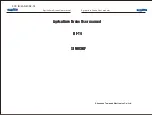
STORMBEE User Manual
–
Think 3D BVBA
Version N°1.1, last modified 30/09/2018
42
Flying your missions in automated flight mode, using GPS waypoints, instead of piloted P-GPS will result
in the most accurate flight path and stabilisation for STORMBEE. Steady accurate flight trajectories
result in accurate GNSS positioning and high quality point cloud data after post-processing. For both
automated and piloted manual flight, try to program/fly as much straight lines as possible. Refrain
from adjusting STORMBEE
’s heading during those straight lines,
as then the GNSS positioning is most
precise and the resulting laser scan point cloud will be most accurate.
The GS Pro app shows the progress of the automated mission (active waypoint, velocity, altitude,…)
at the bottom of the screen.
NOTE
If any other aircraft, drone or bird comes near your mission flight area, take
appropriate actions. Drones should always give way to any other type of aircraft,
balloon, glider, airship and helicopter. Descend immediately or execute an evasive
manoeuvre. If necessary, land immediately.
NOTE
It is possible that the GNSS LED module during flight starts blinking green again after it
was continuously green. This indicates that the GNSS GPS signal acquisition is
(temporarily) of lower quality. As long as this only occurs for a few seconds at a time,
the final point cloud data should still be of sufficient quality.
NOTE
Keep in mind that STORMBEE is a large and heavy multirotor and as such is less nimble
than a small drone. Although its response is quite crisp, its inertia will make it feel like
flying a jumbo jet instead of a small general aviation aircraft. The DJI A3 flight controller
settings are also set to respond less aggressive on purpose for this reason. Keep your
pilot inputs small and gentle.
CAUTION!
Keep in mind that when STORMBEE is moving forward and you set the control stick to
neutral, thus requesting it to hover in P-GPS mode, it will have quite a long braking
distance before it comes to a hover. Both acceleration and deceleration are set to be
gentle!
WARNING!!
Watch STORMBEE at all times during the flight! Thus, the pilot or one of his/her
observers should always be within Visual Line of Sight (VLOS). The pilot should always
keep his/her left-hand index finger on the flight mode switch on top of the DJI
Lightbridge 2 to be able to instantly switch to ATTI-mode if something goes wrong
(without having to first search/feel for the button). DO NOT solely rely on the FPV
screen to estimate distances between STORMBEE and obstacles as the camera has only
a limited field of view and judging distances from a 2D screen is very difficult and
inaccurate.
WARNING!!
The pilot (and/or crew) should continuously re-position him-/herself during the flight
to keep STORMBEE within VLOS with free air between STORMBEE and its nearest
obstacles. It is almost impossible to perceive depth at distances of 50m or more. If
STORMBEE is flying on a straight line between you and a tree/obstacle further on, you
cannot accurately estimate how close STORMBEE is to that tree/obstacle. Re-position
yourself at a(n) (right) angle of the path between STORMBEE and that obstacle. That
way you will see free room (air) between them and can judge the distance between
Summary of Contents for STORMBEE S20
Page 1: ...STORMBEE User Manual Think 3D BVBA 30 09 2018 ...
Page 98: ...STORMBEE User Manual Think 3D BVBA Version N 1 1 last modified 30 09 2018 84 ...
Page 99: ...STORMBEE User Manual Think 3D BVBA Version N 1 1 last modified 30 09 2018 85 ...
Page 100: ...STORMBEE User Manual Think 3D BVBA Version N 1 1 last modified 30 09 2018 86 ...
Page 101: ...STORMBEE User Manual Think 3D BVBA Version N 1 1 last modified 30 09 2018 87 ...
Page 102: ...STORMBEE User Manual Think 3D BVBA Version N 1 1 last modified 30 09 2018 88 ...















































